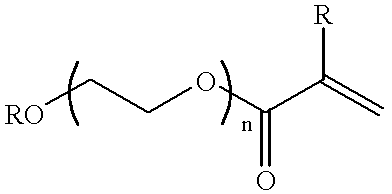Ink composition
a technology of composition and pigment, applied in the field of pigment composition, can solve the problems of pigment dispersions destabilization, dye-based ink jet inks can suffer from deficiencies in waterfastness, smear resistance and lightfastness, and separation from the nozzle of bulging inks,
- Summary
- Abstract
- Description
- Claims
- Application Information
AI Technical Summary
Problems solved by technology
Method used
Image
Examples
example ia
An ink comprised of 4.5 percent by weight of CABOJET 300 carbon black obtained from Cabot Corporation, 20 percent by weight of sulfolane (obtained from Bayer), 0.05 percent by weight of polyethyleneoxide (M.sub.w =18,500 grams / mole) (obtained from Polysciences), and 0.55 percent by weight of resin emulsion derived from Example I was prepared by dissolution of the PEO in water through simple agitation using a stir bar for about 5 minutes, followed by the addition of sulfolane and resin emulsion. This mixture was added to a stirring solution of CABOJET 300 carbon black. The ink mixture was stirred with a stir bar for about 5 to about 10 minutes, and the resulting ink mixture was filtered through a 1 gm glass fiber filter.
example ii
A resin emulsion comprised of resins was derived from 23.6 percent by weight of methacrylic acid, 55.4 percent by weight of benzyl methacrylate, 21 percent by weight of polyethyleneglycol methacrylate (M.sub.w =246 grams / mole), 3 percent by weight of dodecanethiol and 1 percent by weight of carbon tetrabromide.
A one liter kettle equipped with a mechanical stirrer was charged with 240 grams of water, 1.8 grams of sodium dodecylbenzene sulfonate obtained from Rhone-Poulenc as Rhodacal Ds-10, and 2 grams of Triton X-100 (alkylphenoxypolyethanol) available from Aldrich Chemicals, and this mixture was stirred for 2 hours at about 100 revolutions per minute. To this solution were then added 1.8 grams of ammonium persulfate, followed by the addition of an organic mixture containing 28.3 grams of methacrylic acid, 66.5 grams of benzyl methacrylate, 25.2 grams of polyethyleneglycol methacrylate with a molecular weight of 246 grams per mole, 3.6 grams of dodecanethiol and 1.2 grams of carbon ...
example iia
An ink comprised of 4.5 percent by weight of carbon black CABOJET 300 obtained from Cabot, 20 percent by weight of sulfolane (obtained from Bayer), 0.05 percent by weight of polyethyleneoxide (M.sub.w =18,500 grams / mole) (obtained from Polysciences), and 1.0 percent by weight of the resin emulsion of Example II was prepared by the dissolution of the PEO in water through simple agitation using a stir bar for about 5 minutes, followed by the addition of sulfolane and resin emulsion. This mixture was added to a stirring solution of the CABOJET 300 carbon black. The resulting ink mixture was stirred with a stir bar for about 5 to about 10 minutes. The resulting ink mixture was filtered through a 1 .mu.m glass fiber filter. The ink was jetted out of a Xerox 600 dpi hardware and this ink exhibited a latency of 20 seconds.
PUM
| Property | Measurement | Unit |
|---|---|---|
| Time | aaaaa | aaaaa |
| Percent by mass | aaaaa | aaaaa |
| Percent by mass | aaaaa | aaaaa |
Abstract
Description
Claims
Application Information
 Login to View More
Login to View More - R&D
- Intellectual Property
- Life Sciences
- Materials
- Tech Scout
- Unparalleled Data Quality
- Higher Quality Content
- 60% Fewer Hallucinations
Browse by: Latest US Patents, China's latest patents, Technical Efficacy Thesaurus, Application Domain, Technology Topic, Popular Technical Reports.
© 2025 PatSnap. All rights reserved.Legal|Privacy policy|Modern Slavery Act Transparency Statement|Sitemap|About US| Contact US: help@patsnap.com


